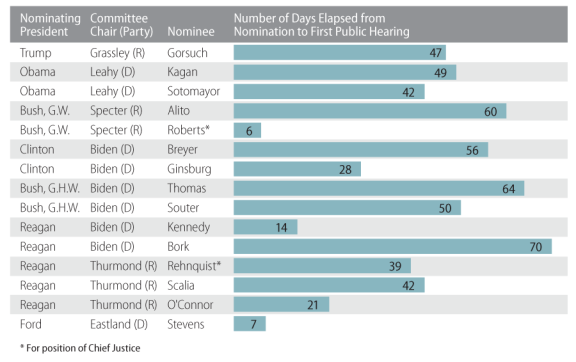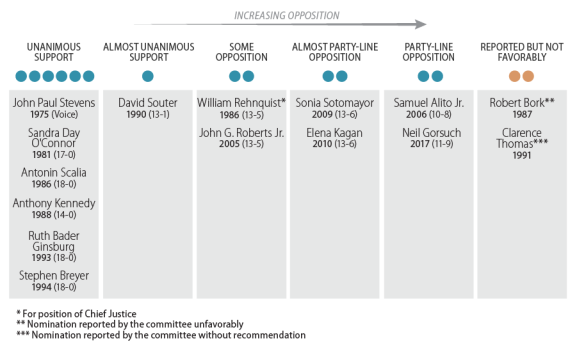Senate Judiciary Committee Hearings for a Supreme Court Nominee: Overview
On July 9, 2018, President Trump announced his selection of Judge Brett Kavanaugh to fill the impending vacancy that will be created on the U.S. Supreme Court by the retirement of Justice Anthony Kennedy on July 31, 2018.
Supreme Court nominations since 1949 have routinely received public confirmation hearings before either the Senate Judiciary Committee or a Judiciary subcommittee. In 1955, hearings on the Supreme Court nomination of John M. Harlan marked the beginning of a practice, continuing to the present, of Court nominees testifying in-person before the Senate Judiciary Committee.
Since 1955, however, there have been 2 nominees (out of a total of 31) who did not receive hearings after being nominated to the Court. In one instance, the nomination of Harriet Miers was withdrawn by President George W. Bush after committee hearings had been scheduled, and in another instance, the nomination of Judge Merrick Garland by President Obama was not given hearings following decisions by Majority Leader McConnell and Senator Grassley, chairman of the Judiciary Committee, not to have the Senate act on the nomination.
This Insight provides an overview of several issues related to the Senate Judiciary Committee's hearings for a Supreme Court nominee. For additional information and analyses on these and other issues, see CRS Report R44236, Supreme Court Appointment Process: Consideration by the Senate Judiciary Committee.
Prehearing Stage
Upon the President's announcement of a nominee, the Judiciary Committee typically initiates an intensive investigation into the nominee's background. One primary source of information is a committee questionnaire to which the nominee responds in writing. The questionnaire asks the nominee for detailed biographical and financial disclosure information, with responses to some questions requiring the retrieval, listing, and summarizing of voluminous information about the nominee's past experiences or activities.
The Judiciary Committee's confidential background investigation of a Supreme Court nominee also closely reviews, among other things, the nominee's past professional activities. In this review, committee members and staff examine the mission of entities that employed or otherwise retained the services of the nominee and the nature and quality of the work product of the nominee while in that service.
During the prehearing stage, the nominee, in accordance with long-standing tradition, visits Capitol Hill to pay "courtesy calls" on individual Senators in their offices. For Senators not on the Judiciary Committee, that may be the only opportunity to converse in person with the nominee before voting on his or her confirmation to the Court.
Also during the prehearing stage, the nominee is evaluated by the American Bar Association's (ABA's) Standing Committee on the Federal Judiciary, which is publicly committed to providing the Senate Judiciary Committee with an impartial evaluation of the qualifications of each Supreme Court nominee. At the culmination of its evaluation, the ABA committee votes on whether to rate a nominee "well qualified," "qualified," or "not qualified." Of the Justices currently serving on the Court, eight received a rating of well qualified and one received a rating of qualified.
Number of Days from Nomination to First Committee Hearing
For nominees since 1975 who have received hearings, Figure 1 shows the number of days that elapsed from the date on which the nomination was formally submitted to the Senate to the date on which the nominee had his or her first hearing before the Judiciary Committee.
Of the 15 nominees listed in the figure, Robert Bork waited the greatest number of days (70) from nomination to his first committee hearing, while John G. Roberts Jr. waited the fewest number of days (6)—followed closely by John Paul Stevens (7).
The most recent nominee to the Court to have hearings, Neil Gorsuch, waited 47 days from the date of his nomination to the date of his first committee hearing. This was similar to the wait time for President Obama's two nominees who received hearings, Sonia Sotomayor and Elena Kagan, who waited 42 and 49 days, respectively.
Overall, for the nominations included in the figure, the average number of days from nomination to first committee hearing is approximately 40 days, while the median is 42 days.
|
Figure 1. Number of Days from Nomination to First Committee Hearing (Nominees Receiving Hearings from 1975 to 2017) |
 |
Reporting the Nomination
Usually within a week of the end of hearings, the Judiciary Committee meets in open session to determine what recommendation to report to the full Senate. The committee may (1) report the nomination favorably, (2) report it negatively, or (3) make no recommendation at all on the nomination.
Figure 2 shows, for nominations reported by the Judiciary Committee since 1975, whether the nomination was reported favorably (identified in columns with solid blue circles) or other than favorably (identified in column with solid orange circles).
For nominations reported favorably, the level of support among committee members is indicated as follows: (1) unanimous support (i.e., no opposition by committee members); (2) almost unanimous support (opposition by one committee member); (3) some opposition (opposition by two or more committee members, but with the nomination also receiving the support of at least two members not of a President's party); (4) almost party-line opposition (opposition by all but one committee member not of a President's party); and (5) party-line opposition (opposition by all committee members not of a President's party).
The number of circles at the top of each column indicates the number of nominees in each category.
Of the 13 nominations reported favorably, 6 were reported with unanimous support (while another 1 was reported with almost unanimous support). The most recent of these 7 nominations was Stephen Breyer's in 1994. None of the 5 most recent nominations to have hearings were reported by the committee unanimously or almost unanimously. Two nominations during this period were reported but not favorably.
|
Figure 2. U.S. Supreme Court Nominees Reported by the Senate Judiciary Committee (1975 to 2017) |
 |